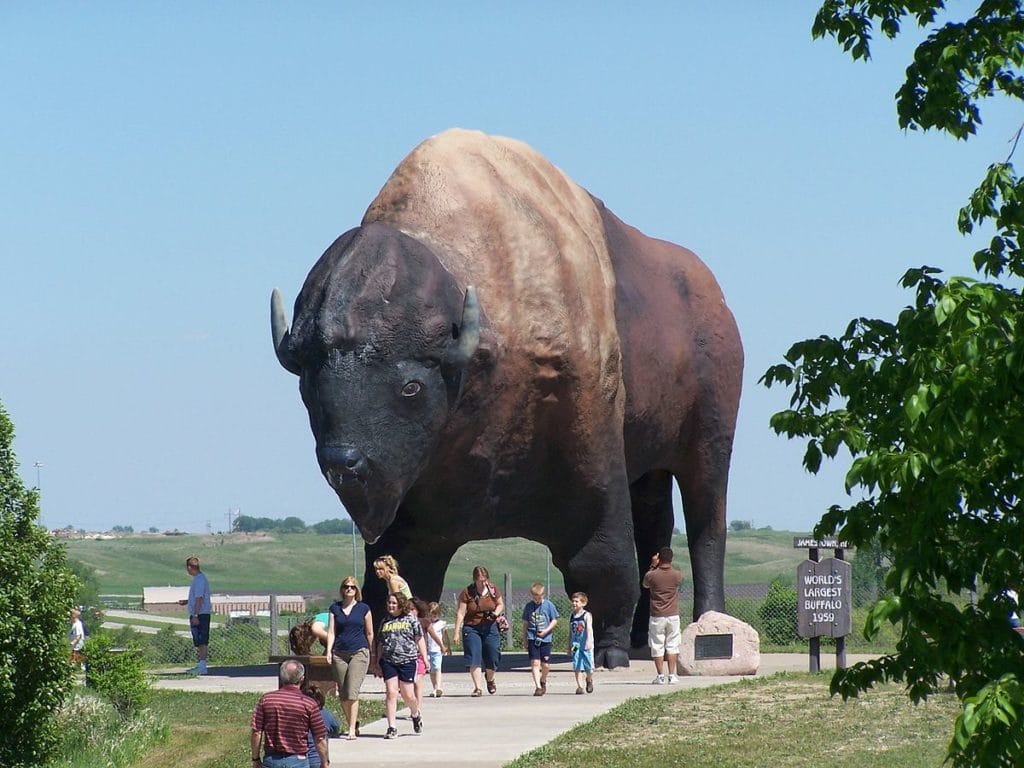Summary of Attractions:
- Theodore Roosevelt National Park
- Bison Monument and Frontier Village
- Three Tribes Museum and Four Bears Bridge
- Fort Mandan Overlook State Historic Site
- Medora Musical
- The North Dakota Heritage Centre
- The Woodchipper from the Movie Fargo
- The State Capitol Complex
- Maah Daah Hey Trail
- International Peace Garden
- The Scandinavian Heritage Park
- Fort Union Trading Post National Historic Site
- National Buffalo Museum
- Plains Art Museum
- Lake Sakakawea and Garrison Dam
North Dakota is a region that has experienced minimal transformation since the era of Theodore Roosevelt – or even Lewis and Clark, for that matter. Roosevelt, an enthusiastic admirer of the state, often sought refuge there during his presidency, describing it as ‘a world of beauty and color and endless space.’
This alluring landscape is perfect for nature enthusiasts, wildlife aficionados, or those seeking outdoor endeavors; North Dakota should rank high on your travel itinerary. This state offers a diverse array of attractions encompassing museums, zoos, theaters, casinos, historical sites, and agritourism, making it an ideal destination for a memorable vacation.
Let us examine the top attractions in North Dakota:
1. Theodore Roosevelt National Park

Encompassing 70,000 acres of canyons, mountains, Badlands, and the Missouri River, this park epitomizes what Theodore Roosevelt cherished most about North Dakota.
The park is divided into two primary sections located approximately 50 miles apart, along with the former Elkhorn Ranch of the president positioned between them.
The southern portion of the park is generally more frequented, largely due to the nearby city of Medora, yet the northern region is equally awe-inspiring.
Visitors can engage in camping, hiking, rock climbing, equestrian activities, or simply enjoy a scenic drive.
During peak season, park rangers provide guided tours and nature presentations throughout the day.
In the evening, partake in a captivating campfire discussion where you can learn about the park’s illustrious namesake.
2. Bison Monument and Frontier Village

Situated between Fargo and Bismarck, the renowned Bison Monument and Frontier Village await your visit.
Witness rare bison grazing near the monument, including the unique albino bison.
The National Buffalo Museum is also present at this locale.
Here, you will gain insight into these majestic creatures and their significant role in the lifestyle of the Plains Indians.
The Frontier Village comprises an array of historical pioneer buildings, such as an old-time barbershop, drugstore, church, jailhouse, post office, schoolhouse, and more.
These structures have been relocated from various frontier locations across the state for preservation purposes.
Visitors can explore the writing cabin of Louis L’Amour, the first railroad depot in Jamestown, and purchase handcrafted items made by local artisans.
If you visit during summer, be sure to catch the Saturday afternoon Wild West shootouts!
3. Three Tribes Museum and Four Bears Bridge

The Mandan, Hidatsa, and Arikara tribes have established this distinctive museum near the Berthold Reservation.
The museum features native arts and crafts, many of which are available for purchase.
In close proximity, the renowned Four Bears Bridge, the longest bridge in North Dakota, spans nearly a mile over Lake Sakakawea.
This bridge has been named after tribal leaders from the three tribes and is adorned with medallions representing these tribes.
4. Fort Mandan Overlook State Historic Site

In 1804, Lewis and Clark played a role in constructing Fort Mandan, necessitated by their arrival during winter to establish a base camp.
It was in this fort that they met Sacagawea, their esteemed guide, and conducted interviews with various tribal individuals.
Although the original fort was claimed by the river, historians and archaeologists have endeavored to recreate the lifestyle of that period when the explorers were present.
Today, the site features interactive exhibits revealing the fort’s history and its current condition.
The visitors’ center showcases artifacts discovered on-site and offers the chance to walk in the footsteps of these illustrious explorers.
5. Medora Musical

Prior to his presidency, Teddy Roosevelt lived as a spirited cowboy of the declining Western frontier.
This outdoor performance in Medora, situated next to Theodore Roosevelt National Park, showcases his life through dance, music, fireworks, and live animal acts.
First produced in the 1950s, it has since evolved into a premier attraction.
The town has been reconstructed and renovated, now offering numerous outdoor activities and entertainment options that provide an unparalleled experience of the American Old West.
6. The North Dakota Heritage Centre

Spanning from prehistoric times to the contemporary period, the North Dakota Heritage Centre encompasses a wide array of historical and cultural topics.
The museum reopened in 2014 with expanded exhibit space, showcasing everything from dinosaurs to Norwegian bachelor farmers and nuclear silos.
A notable statue of Sacagawea, the illustrious guide for Lewis and Clark, greets visitors out front, while four galleries delve into the state’s history and its contributions to the nation’s development.
7. The Woodchipper from the Movie Fargo

If you have yet to watch the Coen Brothers film, ‘Fargo,’ prepare yourself for a cult classic.
The actual woodchipper featured in the film is currently displayed at the Fargo Moorhead Visitors Centre in Fargo.
Visitors can recreate the iconic scene using authentic movie costumes and a prop leg.
This location has become one of the most sought-after photo opportunities in the city, sure to provide entertaining stories upon your return home.
8. The State Capitol Complex

The North Dakota state capitol stands out among its counterparts across the United States.
Often termed the ‘skyscraper of the prairie,’ it showcases a tall, Stalin-esque architectural style with Art Deco finishes.
Visitors can use the elevator to ascend to an observation deck on the 18th floor, where they can take in views of the city of Bismarck and its surroundings.
At 241 feet tall, the building was constructed in the 1930s.
While in the area, explore the prairie trail, government memorials, the arboretum, and the nearby North Dakota Heritage Museum.
9. Maah Daah Hey Trail

This trail, nearly 100 miles in length, connects the northern and southern sections of Theodore Roosevelt National Park.
Referred to as the Maah Daah Hey Trail, its symbol is a turtle, representing determination and patience.
Such traits will certainly be beneficial if you opt to hike it.
Certain segments can be quite challenging, featuring rugged Badlands and stunning prairie landscapes.
Wildlife enthusiasts will be delighted to spot coyotes, golden eagles, deer, bighorn sheep, and even bison.
Visitors can hike, bike, and ride horseback, with opportunities for camping along this enchanting stretch of national park.
10. International Peace Garden

North Dakota shares a boundary with Canada, where trails and gardens commemorate the longstanding peace between the two nations.
The International Peace Garden spans 2,300 acres, divided equally between Canada and the United States.
Open throughout the year, the Interpretive Centre features a gift shop, a conservatory housing over 3,000 species of cacti, and a restaurant.
Located in the Turtle Mountains, it sits in the heart of Turtle Island – the original Indigenous American designation for North America.
Established over 80 years ago, visitors may camp, hike, bike, and observe wildlife within the refuge. Keep an eye out for moose!
11. The Scandinavian Heritage Park

Minot is the location of the Scandinavian Heritage Park, which honors the many pioneers from Norway, Sweden, Denmark, Finland, and Iceland.
Initiated in the late 1980s, the center boasts a significant international membership, with a foundation dedicated to preserving history while fostering new connections for the future.
Visitors can view an authentic dwelling from Sigdal, Norway, meticulously transported to the site.
Don’t overlook the replica of the Gol Stave Church and the genuine Finnish sauna, perfect for relaxation.
The park pays tribute to the pioneering spirit of the many Scandinavians who sought better lives on the American frontier.
12. Fort Union Trading Post National Historic Site

Once regarded as the grandest fort along the Missouri River, Fort Union was a pivotal fur trading post throughout much of the 19th century.
The expansive white mansion, serving as the residence for the head merchant and his family, starkly contrasts with the surrounding environment.
Constructed in the most impressive manner, its purpose was to garner respect from the Assiniboine and other Plains tribes.
It is estimated that over 25,000 buffalo hides were traded annually here.
Though operational during turbulent times, the fort maintained a reputation for its peaceful interactions among the various traders present.
While visiting, you may explore the house independently or with a guided tour.
13. National Buffalo Museum

North Dakota uniquely hosts three albino buffalo.
The most renowned among them is White Cloud, who is deeply revered by many Native tribes.
She was born in 1996 and resided within a herd on the plains near the museum for approximately 20 years.
Throughout her lifetime, she bore 11 calves, including an albino calf named Dakota Miracle.
The museum gained additional fame when a brown buffalo gave birth to a white calf called Dakota Legend.
The museum grounds hold sacred significance for many, making a visit truly transformative.
14. Plains Art Museum

Situated in the International Harvester warehouse, the Plains Art Museum is a well-regarded stop in Fargo.
Here, you will find a collection exceeding 3,000 pieces from both regional and national artists.
Explore works by Impressionists such as Mary Cassatt and contemporary Native artists like George Morrison.
Originating from the Moorhead post office, the museum has expanded into a facility exceeding 50,000 square feet, housing the Katherine Kilbourne Burgum Centre for Creativity.
This multifunctional space offers classes and exhibition areas for artists and art enthusiasts alike.
15. Lake Sakakawea and Garrison Dam

The Garrison Dam, a component of the Missouri River, was constructed during the mid-20th century.
The dam’s lobby displays informative exhibits regarding its construction and the adjacent Lake Sakakawea.
Visitors can tour the power plant and then venture to the lake for outdoor recreational activities.
Lake Sakakawea, nearly 200 miles long, ranks as the third-largest man-made lake in the United States.
Named after Sacagawea, the Shoshone guide who assisted Lewis and Clark, the lake is a favored destination for fishermen from distant places.
Keep an eye out for Wally, the impressive 26-foot fiberglass Walleye.





